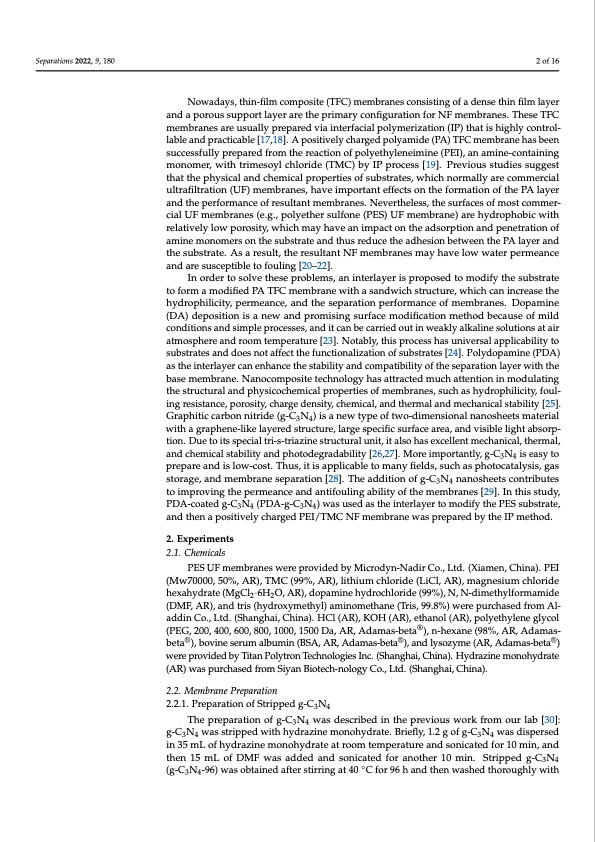
PDF Publication Title:
Text from PDF Page: 002
Separations 2022, 9, 180 2 of 16 Nowadays, thin-film composite (TFC) membranes consisting of a dense thin film layer and a porous support layer are the primary configuration for NF membranes. These TFC membranes are usually prepared via interfacial polymerization (IP) that is highly control- lable and practicable [17,18]. A positively charged polyamide (PA) TFC membrane has been successfully prepared from the reaction of polyethyleneimine (PEI), an amine-containing monomer, with trimesoyl chloride (TMC) by IP process [19]. Previous studies suggest that the physical and chemical properties of substrates, which normally are commercial ultrafiltration (UF) membranes, have important effects on the formation of the PA layer and the performance of resultant membranes. Nevertheless, the surfaces of most commer- cial UF membranes (e.g., polyether sulfone (PES) UF membrane) are hydrophobic with relatively low porosity, which may have an impact on the adsorption and penetration of amine monomers on the substrate and thus reduce the adhesion between the PA layer and the substrate. As a result, the resultant NF membranes may have low water permeance and are susceptible to fouling [20–22]. In order to solve these problems, an interlayer is proposed to modify the substrate to form a modified PA TFC membrane with a sandwich structure, which can increase the hydrophilicity, permeance, and the separation performance of membranes. Dopamine (DA) deposition is a new and promising surface modification method because of mild conditions and simple processes, and it can be carried out in weakly alkaline solutions at air atmosphere and room temperature [23]. Notably, this process has universal applicability to substrates and does not affect the functionalization of substrates [24]. Polydopamine (PDA) as the interlayer can enhance the stability and compatibility of the separation layer with the base membrane. Nanocomposite technology has attracted much attention in modulating the structural and physicochemical properties of membranes, such as hydrophilicity, foul- ing resistance, porosity, charge density, chemical, and thermal and mechanical stability [25]. Graphitic carbon nitride (g-C3N4) is a new type of two-dimensional nanosheets material with a graphene-like layered structure, large specific surface area, and visible light absorp- tion. Due to its special tri-s-triazine structural unit, it also has excellent mechanical, thermal, and chemical stability and photodegradability [26,27]. More importantly, g-C3N4 is easy to prepare and is low-cost. Thus, it is applicable to many fields, such as photocatalysis, gas storage, and membrane separation [28]. The addition of g-C3N4 nanosheets contributes to improving the permeance and antifouling ability of the membranes [29]. In this study, PDA-coated g-C3N4 (PDA-g-C3N4) was used as the interlayer to modify the PES substrate, and then a positively charged PEI/TMC NF membrane was prepared by the IP method. 2. Experiments 2.1. Chemicals PES UF membranes were provided by Microdyn-Nadir Co., Ltd. (Xiamen, China). PEI (Mw70000, 50%, AR), TMC (99%, AR), lithium chloride (LiCl, AR), magnesium chloride hexahydrate (MgCl2·6H2O, AR), dopamine hydrochloride (99%), N, N-dimethylformamide (DMF, AR), and tris (hydroxymethyl) aminomethane (Tris, 99.8%) were purchased from Al- addin Co., Ltd. (Shanghai, China). HCl (AR), KOH (AR), ethanol (AR), polyethylene glycol (PEG, 200, 400, 600, 800, 1000, 1500 Da, AR, Adamas-beta®), n-hexane (98%, AR, Adamas- beta®), bovine serum albumin (BSA, AR, Adamas-beta®), and lysozyme (AR, Adamas-beta®) were provided by Titan Polytron Technologies Inc. (Shanghai, China). Hydrazine monohydrate (AR) was purchased from Siyan Biotech-nology Co., Ltd. (Shanghai, China). 2.2. Membrane Preparation 2.2.1. Preparation of Stripped g-C3N4 The preparation of g-C3N4 was described in the previous work from our lab [30]: g-C3N4 was stripped with hydrazine monohydrate. Briefly, 1.2 g of g-C3N4 was dispersed in 35 mL of hydrazine monohydrate at room temperature and sonicated for 10 min, and then 15 mL of DMF was added and sonicated for another 10 min. Stripped g-C3N4 (g-C3N4-96) was obtained after stirring at 40 ◦C for 96 h and then washed thoroughly withPDF Image | Nanofiltration Membrane Using Polydopamine Carbon Nitride

PDF Search Title:
Nanofiltration Membrane Using Polydopamine Carbon NitrideOriginal File Name Searched:
separations-09-00180.pdfDIY PDF Search: Google It | Yahoo | Bing
Product and Development Focus for Infinity Turbine
ORC Waste Heat Turbine and ORC System Build Plans: All turbine plans are $10,000 each. This allows you to build a system and then consider licensing for production after you have completed and tested a unit.Redox Flow Battery Technology: With the advent of the new USA tax credits for producing and selling batteries ($35/kW) we are focussing on a simple flow battery using shipping containers as the modular electrolyte storage units with tax credits up to $140,000 per system. Our main focus is on the salt battery. This battery can be used for both thermal and electrical storage applications. We call it the Cogeneration Battery or Cogen Battery. One project is converting salt (brine) based water conditioners to simultaneously produce power. In addition, there are many opportunities to extract Lithium from brine (salt lakes, groundwater, and producer water).Salt water or brine are huge sources for lithium. Most of the worlds lithium is acquired from a brine source. It's even in seawater in a low concentration. Brine is also a byproduct of huge powerplants, which can now use that as an electrolyte and a huge flow battery (which allows storage at the source).We welcome any business and equipment inquiries, as well as licensing our turbines for manufacturing.| CONTACT TEL: 608-238-6001 Email: greg@infinityturbine.com | RSS | AMP |